* Snug as a bug in a… sleeping bag! *
Having the right kind of sleeping gear and using it appropriately is crucial for a hiker who needs to recover from a hard day’s toil through a night’s restful sleep.
How warm you sleep in the outdoors depends on some key factors:
- Ambient temperature
- Whether you are inside a tent or sleeping out in the open
- Your food intake in the immediate past
- Your general state of wellbeing
- Your sleeping gear and the manner in which you use it
In this post we are considering one item from sleeping gear and its usage: sleeping bag.
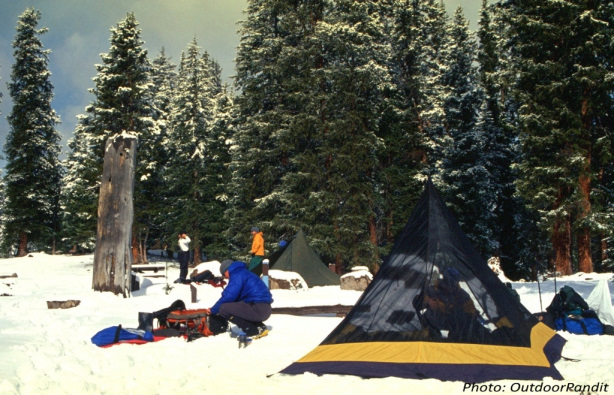
Sleeping bag
A sleeping bag’s effectiveness and efficiency in trapping your body heat is defined by
- Design of your sleeping bag
- Manner in which you are using your sleeping bag
- Quality of your sleeping mat – your body compresses a sleeping bag’s insulation beneath you
EN and ISO Standards for sleeping bags ensure that, among other things, there is some uniformity among all sleeping bags in terms of their ‘comfort rating’ and ‘season rating’. These standards do not apply to sleeping bags used for a) specific purpose like military use and extreme condition expeditions and b) children and babies.
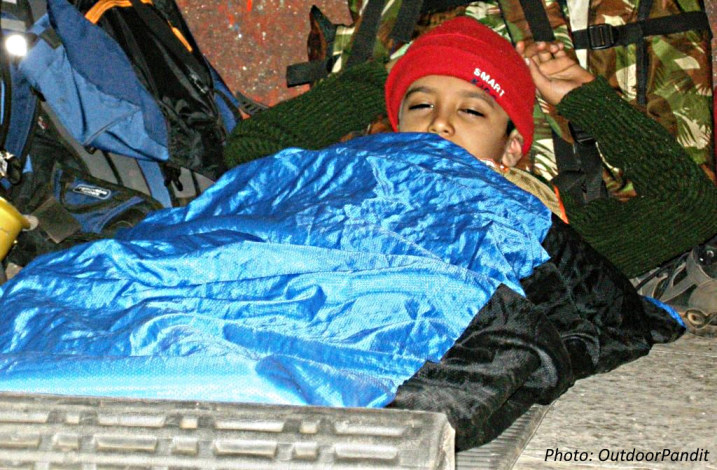
- Comfort rating of a sleeping bag refers to the temperature-range in which the average male or female will feel too warm, comfortable, or be able to survive in the sleeping bag. If you tend to ‘sleep cold’ then go for a range lower than what is claimed to be advisable for the hike you are going on. E.g., if you are going on a trek in the Himalaya in summer and the least temperature expected is about 0°C then go for a sleeping bag with comfort rating that begins below 0°C, say -5°
- Season rating refers to time of the year. The rating ranges from ‘One-Season’ that is good for 5°C and above, to all the way up to ‘Four-Season’ that is good for as low a temperature as -10°C. For a winter hike, go for ‘Four-Season’. ‘Five-Season’ sleeping bags are meant for extreme weather.
Most sleeping bags are made of nylon fabric. Two main considerations will help you decide upon the choice of a sleeping bag for a particular hike: its filling and shape.
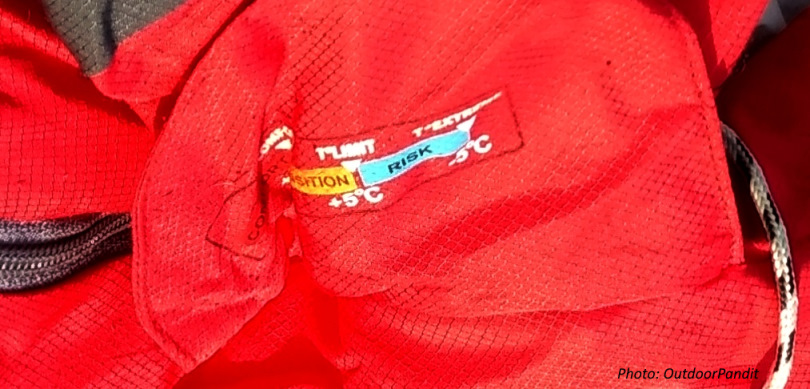
Material of sleeping bags
The filling can be down feathers or synthetic material.
Down feathers are soft, fluffy feathers that are closest to the body of a bird where they trap body heat. Synthetic filling comes in many forms and works like down to effectively trap air for insulation. Typically, a sleeping bag has patterned stitching all across called baffles which keep its filling evenly distributed and prevent it from clumping up in a few spots.
Synthetic material is, weight for weight, less warm and bulkier than down but retains a considerable amount of its ability to keep you warm despite being wet and it also dries fast. Down, when wet, becomes a sad lump, loses most of its insulation and takes forever to dry. The compressibility of down is remarkable and its warmth-to-weight ratio unmatched.
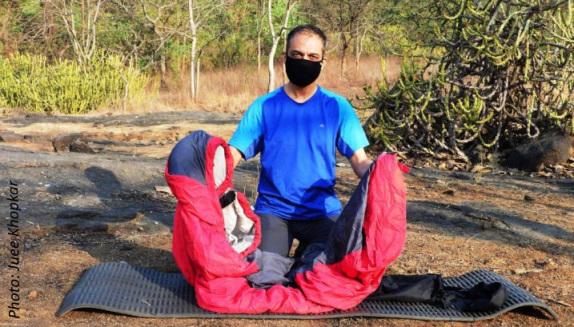
Shape of sleeping bag
The following should suffice for making a choice on what shape is suitable for you on hiking trips in non-extreme weather conditions:
- Rectangular: wide enough for the typical tosser and turner! This shape is comparatively not so effective with insulation since there is too much space around a sleeper.
- Mummy shaped: fits around the shape of the human body, less room for turning within. With draw-cords in the hood, this sleeping bag works amazingly well in trapping body heat.
- In-between shape: results of efforts to combine features of the two shapes mentioned above.
- There should be enough space for your feet so that your toes do not press against the fabric because that can create ‘cold spots’
- Size of the sleeping bag should allow you to get in completely – if it is too tight then a) you will feel cramped and b) wherever your body presses against the bag there will be cold spots since the filling in those spots will get compressed
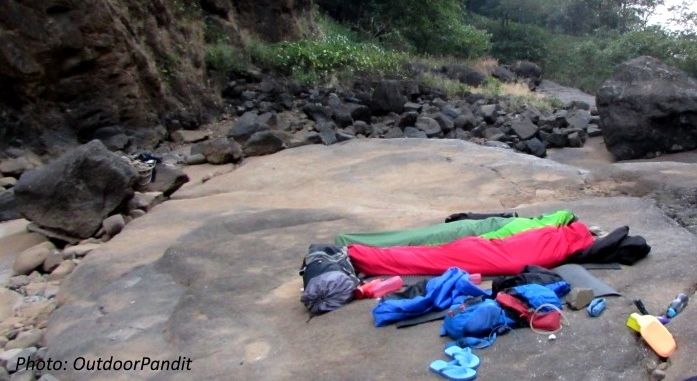
Parts of sleeping bag
Understanding of parts of sleeping bag can influence your decision to buy and use a sleeping bag.
- Outer fabric is usually wind resistant and abrasion resistant. If it is made of ‘rip-stop’ fabric then that prevents a tiny tear from spreading. Inner fabric is much softer and skin-friendly.
- Hood is important in trapping body heat. Ensure that there is a draw-cord to close the hood as per your comfort.
- Draft collar is a tubular puffy insulation stitched in to further help in trapping body heat. With this collar tightened, you can afford to have the hood opened up a little bit.
- Recommended: zippers that can be operated from the inside and outside. Two zippers that work in opposite directions allow you to open the lower part of your sleeping bag in case it gets too warm for you.
- Little pockets near the top are handy for storing items like medicines, wrist watches, and spare batteries.
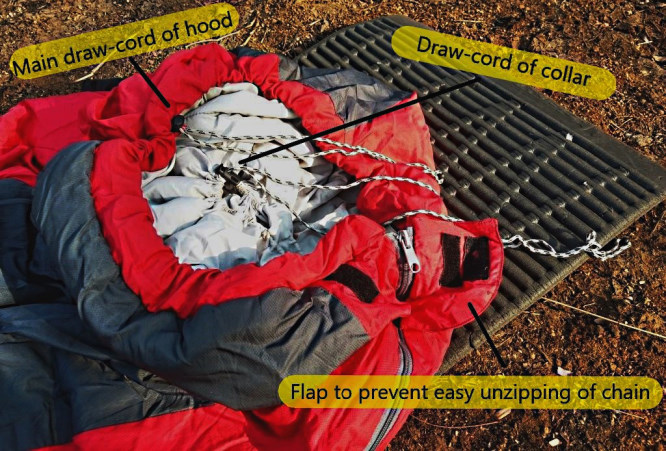
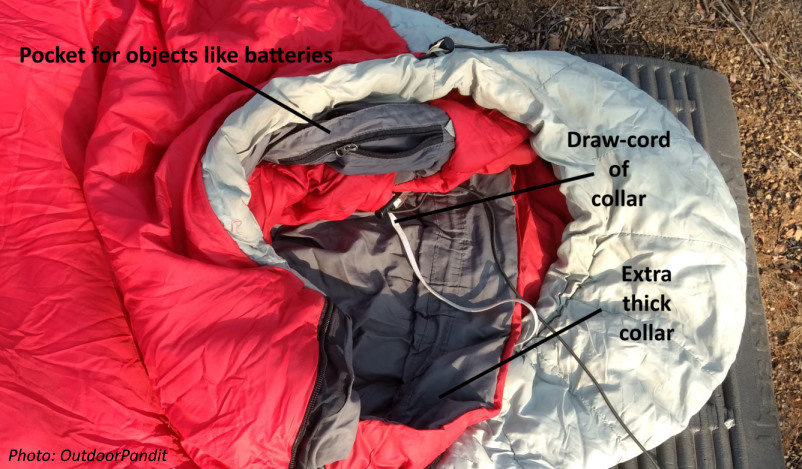
Using a sleeping bag appropriately
Read about how to use a sleeping bag effeciently in my post ‘Sleeping gear: sleeping bag 2 – Use’
Packing a sleeping bag
Read about how to pack a sleeping bag for all weather conditions in my post ‘Sleeping Bag Packing Tips’

In army we used to get the Mummy type SB. They were good. Once we are in it the part in contact with our body was warm rest was over cold. This ensured we never moved while sleeping!:)
Now that certainly is one ‘mode’ of sleeping ha ha! On a serious note, it does take time for the whole of sleeping bag to warm up, and one ‘tip’ to speed up the process is to do push-ups or sit-ups before quickly sliding into one’s sleeping bag. The warmed up body quickly warms up the interiors!! So, Kedar, thanks once again – your replies tend to make me remember stuff that is ‘practical tips’. Keep them coming, and in your inimitable style!